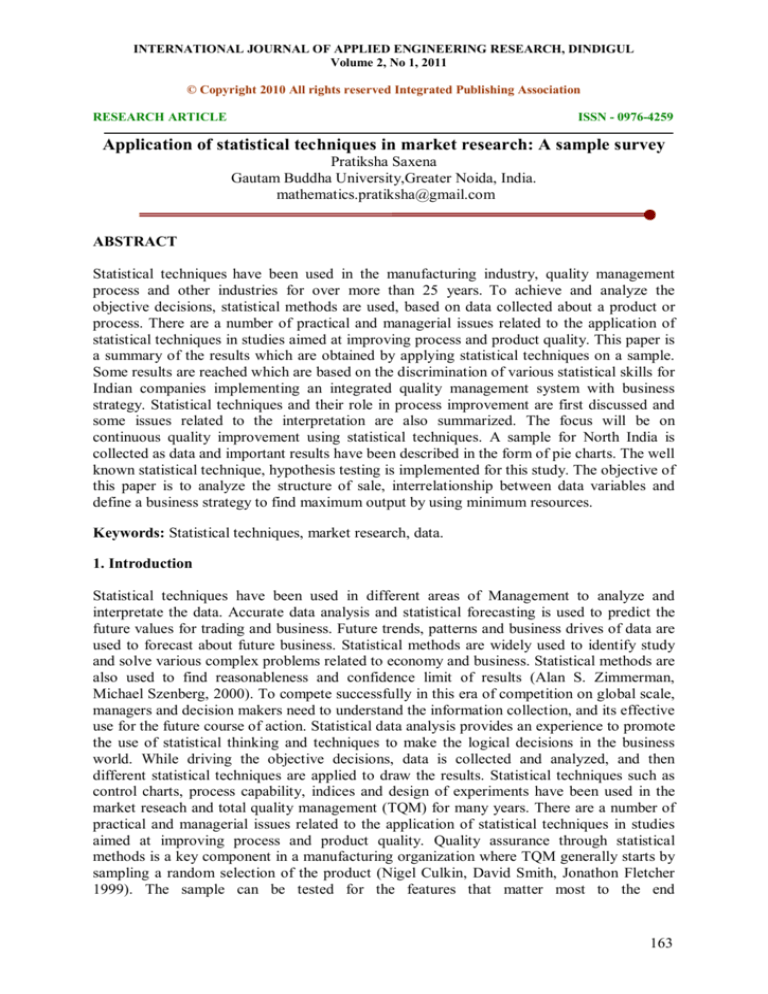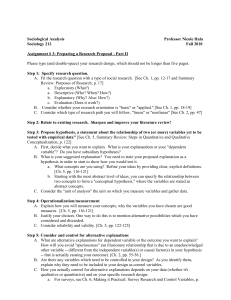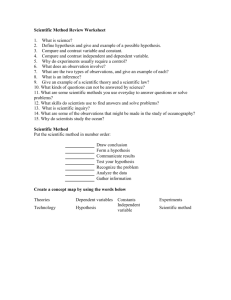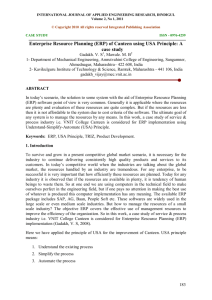
INTERNATIONAL JOURNAL OF APPLIED ENGINEERING RESEARCH, DINDIGUL Volume 2, No 1, 2011 © Copyright 2010 All rights reserved Integrated Publishing Association RESEARCH ARTICLE ISSN ­ 0976­4259 Application of statistical techniques in market research: A sample survey Pratiksha Saxena Gautam Buddha University,Greater Noida, India. mathematics.pratiksha@gmail.com ABSTRACT Statistical techniques have been used in the manufacturing industry, quality management process and other industries for over more than 25 years. To achieve and analyze the objective decisions, statistical methods are used, based on data collected about a product or process. There are a number of practical and managerial issues related to the application of statistical techniques in studies aimed at improving process and product quality. This paper is a summary of the results which are obtained by applying statistical techniques on a sample. Some results are reached which are based on the discrimination of various statistical skills for Indian companies implementing an integrated quality management system with business strategy. Statistical techniques and their role in process improvement are first discussed and some issues related to the interpretation are also summarized. The focus will be on continuous quality improvement using statistical techniques. A sample for North India is collected as data and important results have been described in the form of pie charts. The well known statistical technique, hypothesis testing is implemented for this study. The objective of this paper is to analyze the structure of sale, interrelationship between data variables and define a business strategy to find maximum output by using minimum resources. Keywords: Statistical techniques, market research, data. 1. Introduction Statistical techniques have been used in different areas of Management to analyze and interpretate the data. Accurate data analysis and statistical forecasting is used to predict the future values for trading and business. Future trends, patterns and business drives of data are used to forecast about future business. Statistical methods are widely used to identify study and solve various complex problems related to economy and business. Statistical methods are also used to find reasonableness and confidence limit of results (Alan S. Zimmerman, Michael Szenberg, 2000). To compete successfully in this era of competition on global scale, managers and decision makers need to understand the information collection, and its effective use for the future course of action. Statistical data analysis provides an experience to promote the use of statistical thinking and techniques to make the logical decisions in the business world. While driving the objective decisions, data is collected and analyzed, and then different statistical techniques are applied to draw the results. Statistical techniques such as control charts, process capability, indices and design of experiments have been used in the market reseach and total quality management (TQM) for many years. There are a number of practical and managerial issues related to the application of statistical techniques in studies aimed at improving process and product quality. Quality assurance through statistical methods is a key component in a manufacturing organization where TQM generally starts by sampling a random selection of the product (Nigel Culkin, David Smith, Jonathon Fletcher 1999). The sample can be tested for the features that matter most to the end
163 INTERNATIONAL JOURNAL OF APPLIED ENGINEERING RESEARCH, DINDIGUL Volume 2, No 1, 2011 © Copyright 2010 All rights reserved Integrated Publishing Association RESEARCH ARTICLE ISSN ­ 0976­4259 users. Information is gathered about the product goodwill, sales, price, method of distribution and marketing. After collecting the data, it is analyzed on past sales to predict future sales. Analysis is also made to improve the sale and goodwill of product. Market research analysis is a procedure to design survey and to assess consumer performance (Robert P. Hamlin, 2000). Different methods and procedures are used to organize survey and to assess consumer performance. Data is collected through different channels; it may be of two types; Primary data and Secondary Data. It may be through primary data collection technique, which is conducted through the Internet and telephone, focus group discussions, mail responses, or setting up booths in public places, such as shopping malls. Trained interviewers usually conduct the surveys under a market research analyst's direction. Use of secondary data is another statistical technique which is used in this research design. Market research analysts devise methods and procedures for obtaining the data they need by designing surveys to assess consumer preferences. In this paper, statistical techniques are used in the area of market research to compare the sale of APPERAL for last and current year. Data is collected for seven states of North India. The work line is to compare data by means of well known statistical pie­chart and then analysis is done by test of hypothesis technique. Market research is also helpful to develop advertising brochures and commercials, sales plans, and product promotions such as rebates and giveaways based on their knowledge of the consumer being targeted. The information also may be used to determine whether the company should add new lines of merchandise, open new branches, or otherwise diversify the company's operations (George Heinrich, 2006). It depends on the objective of market research that which statistical technique is to use to collect the data, analysis method and conclusion report. Survey researchers design surveys in many different formats, depending upon the scope of their research and the method of collection. It is used to establish which portion of the population will or does purchase a product, based on age, gender, location, income level and many other variables. Market research allows companies to learn more about past, current and potential customers, including their specific likes and dislikes (Miriam Catterall, 1998). Research may be defined as a search of knowledge or any short of systematic investigation of past or future facts. The basic need of research is to discover, interpreting and developing the various application that can be effectively used in various fields to get the authentic outcome of problems due to which the possibilities of diversions are increasing. Two definitions of Market Research are given as, according to American Marketing Association (AMA) ­ Official Definition of Marketing Research “Marketing research is about researching the whole of a company’s marketing process.” According to Palmer (2000), "Marketing research is the function that links the consumer, customer, and public to the marketer through information ­ information used to identify and define marketing opportunities and problems; generate, refine, and evaluate marketing actions; monitor marketing performance; and improve understanding of marketing as a process. Marketing research specifies the information required to address these issues, designs the methods for collecting information, manages and implements the data collection process, analyzes, and communicates the findings and their implications."
164 INTERNATIONAL JOURNAL OF APPLIED ENGINEERING RESEARCH, DINDIGUL Volume 2, No 1, 2011 © Copyright 2010 All rights reserved Integrated Publishing Association RESEARCH ARTICLE ISSN ­ 0976­4259 After collecting the information in the form of data, it comes to analysis stage. Analysis of data includes so many statistical techniques, which can broadly be categorized in to two parts; exploratory methods and confirmatory methods. Exploratory methods are used to discover what the data seems to be saying by using simple arithmetic and easy­to­draw pictures to summarize data. Confirmatory methods use ideas from probability theory in the attempt to answer specific questions. Probability is important in decision making because it provides a mechanism for measuring, expressing, and analyzing the uncertainties associated with future events. Interference, Test of hypothesis, Estimation theory and Analysis of Variance are some of the methods which are very important to estimate the characteristic of population on the basis of sample. The results may be reported in the form of a table, a graph or a set of percentages. As results are based on only a small collection (sample), and not an entire population, the reported results must reflect the uncertainty through the use of probability statements and intervals of values. A critical aspect of managing any organization is planning for the future. Good judgment, intuition, and an awareness of the state of the economy may give a manager a rough idea or feeling of what is likely to happen in the future. However, converting that feeling into a number that can be used effectively is difficult. Statistical data analysis helps managers to forecast and predict future aspects of a business operation. The use of information effectively is the main aspect of decision making, which is very important in Managerial Decisions of Market. 2. Literature Review An extended model of the research process, incorporating the tasks that are essential for targeting and reporting is developed. The model and the six prerequisites are then used as the basis for the development of an operational procedure that allows a targeted set of research hypotheses to be developed from a decision problem, together with a formal record of the logical links between them. Another model is developed, where assumptions of mainstream marketing simply do not apply. Three sectors of the economy: the formal firm­type sector; the state­controlled planned sector; and the bazaar, where the traditional focus is not on the transaction but on personal relationships are defined and reports on ethnographic research conducted in the Kyrgyz Republic (David Marsden, Dale Littler, 2000). A model examines some of the applications of repertory grid technique and theory to qualitative market research. In particular, it shows how together they can be used to explore five basic components of the network of subjective meanings that consumers attach to their consumption experiences. Another preliminary study, based on interviews with 39 experienced market research managers, shows that most qualitative techniques are used in nearly every one of the 17 countries (Claudio Vignali, Demetris Vronti, 2000). International researchers interviewed are well aware of the cultural problems they may face in completing international qualitative research. This research into the UK beer/brewing industry uses a quantitative­based survey and seeks to investigate and analyze the national beer market for a major brewer. Rosemary Duff discusses the findings of a market research program carried out by SMRC ChildWise on behalf of Tetra Pak UK Ltd, examining use of and attitudes to soft drinks among children and mothers. The research examined behaviour across the key drinking occasions that make up
165 INTERNATIONAL JOURNAL OF APPLIED ENGINEERING RESEARCH, DINDIGUL Volume 2, No 1, 2011 © Copyright 2010 All rights reserved Integrated Publishing Association RESEARCH ARTICLE ISSN ­ 0976­4259 the child's day, looking in detail at drinks consumed at school. This study analyses the response rates of a targeted and non­targeted group to a financial questionnaire. The targeted group provided more complete and useful data than the non­targeted group. The conclusions indicate strategies for using e­mail to gather customer information. An empirical study was conducted for 192 large and small companies that indicate, small firms are using new media technologies to level the competitive playing field. Focus Groups were used as effective strategy in consumer research if conducted properly. If focus groups are contrived using true qualitative characteristics, this method may yield the strongest data for use by consumer and marketing researchers in truly identifying with customers today. SMEs are both users of marketing research and subjects of market research. This paper considers the value of using in­depth qualitative research to establish the unique features of business support required by small firms. In addition to a review of recent studies that have adopted ethnographic, repertory grid and cognitive mapping qualitative approaches in this context, the paper presents the results from a specific study where the repertory grid procedure was used to establish the risk management practices of high technology small firms. Conclusions are drawn concerning the strengths and limitations of qualitative market research in designing SME training/development support (John Sparrow, 1999). During the 1980s, market research practitioners and academic marketing researchers witnessed a growing interest in qualitative research. A review of the practitioner and academic literature on qualitative market(ing) research reveals the commonalities and the differences in the ways each group represents, thinks about and practices qualitative research. Areas where both groups might benefit from sharing ideas and information and from closer links generally are discussed (Miriam Catterall,1998). 3. Problem Statement Data collection is one of the most important tasks of the research. After defining research problem, data is collected for next step. This data may be of primary or secondary data. This research is based on observations, which is made on data collected from 7states, taking into consideration 102 different stores of these states. The object for which data is collected is Apparels. Data is collected in the form of sample as it consists of data for different stores of 7 states of North India. Data consists of Sale and Quantity for current and last year for three months January, February and March. This data will work as secondary data for research work. The data which already exists since it has been collected for other purposes. Data is shown in Table 1 in the form of percentage for different states. A pie chart is constructed representing Total sale of States in Fig. 1. Table 2 represents data converted for pie chart. Pie chart is a statistical, circular chart divided into sectors, representing proportion. In a pie chart, the arc length of each sector is proportional to the quantity it represents. It is named for its resemblance to a pie which has been sliced. Pie charts can be an effective way of displaying information in some cases, in particular if the intent is to compare the size of a slice with the whole pie, rather than comparing the slices among them (Spence, Ian 2005). Pie charts are good when you are showing the relative proportion of numbers that add up to a total. They are good for a single series of data (V. Venugopal, W. Baets, 1994). They are best
166 INTERNATIONAL JOURNAL OF APPLIED ENGINEERING RESEARCH, DINDIGUL Volume 2, No 1, 2011 © Copyright 2010 All rights reserved Integrated Publishing Association RESEARCH ARTICLE ISSN ­ 0976­4259 when there are not too many wedges, particularly too many small ones. A pie chart compares parts to a whole. As such it shows a percentage distribution. The entire pie represents the total data set and each segment of the pie is a particular category within the whole. Table 1: Percentage of sales for year 2009 and 2010 State Last Year Sale Percentage Delhi 26.19% Current Year Sale Percentage 31.38% Kanpur 0 3.29% N. C. R. 26.58% 11.82% U. P 9.25% 11.41% Panjab 23.92% 31.66% Himachal 2.59% 3.08% Rajasthan 11.45% 7.32% Table 2: Sale proportion (in degrees) for year 2009 and 2010 State Delhi Last Year Sale Percentage (In Degrees) 94.315 Current Year Sale Percentage (In Degrees) 112.996 Kanpur 0 11.875 N. C. R. 95.715 42.585 U. P 33.325 41.093 Panjab 86.099 113.99 Himachal 9.329 11.102 Rajasthan 41.214 26.35
167 INTERNATIONAL JOURNAL OF APPLIED ENGINEERING RESEARCH, DINDIGUL Volume 2, No 1, 2011 © Copyright 2010 All rights reserved Integrated Publishing Association RESEARCH ARTICLE ISSN ­ 0976­4259 Delhi NCR Himachal Rajasthan Panjab U.P
Figure 2: Pie chart for sale of seven states Next statistical technique, which is used to explore and analyze the data, is test of hypothesis. T­test is used to compare sale of two years and to analyze whether there is any improvement in the current year sale. Data is collected for sample of 7states and result is generalized for North India Region. 5% level of significance is used for this test. Testing of Hypothesis is an important tool of Statistics. Setting up and testing hypotheses is an essential part of statistical inference (Cleveland, William S., 1985). In order to formulate a test, usually some theory has been put forward, either because it is believed to be true or because it is to be used as a basis for argument, but has not been proved, for example, claiming that a new drug is better than the current drug for treatment of the same symptoms. In this method, the question of interest is simplified into two competing hypotheses between which we have a choice; the null hypothesis, denoted as H0, against the alternative hypothesis, denoted as H1. The hypotheses are often statements about population parameters like expected value and variance. The alternative hypothesis, H1, is a statement of what a statistical hypothesis test is set up to establish. The outcome of a hypothesis test is "Reject H0 in favour of H1" or "Do not reject H0". If we conclude "Do not reject H0", this does not necessarily mean that the null hypothesis is true; it only suggests that there is not sufficient evidence against H0 in favour of H1. Rejecting the null hypothesis then, suggests that the alternative hypothesis may be true. The critical value for a hypothesis test is a threshold, to which the value of the test statistic in a sample is compared to determine whether, or not the null hypothesis is rejected. The critical value for any hypothesis test depends on the significance level at which the test is carried out, 168 INTERNATIONAL JOURNAL OF APPLIED ENGINEERING RESEARCH, DINDIGUL Volume 2, No 1, 2011 © Copyright 2010 All rights reserved Integrated Publishing Association RESEARCH ARTICLE ISSN ­ 0976­4259 and whether the test is one­sided or two­sided. The significance level of a statistical hypothesis test is a fixed probability of wrongly rejecting the null hypothesis H0, if it is in fact true. In this study t­test for two samples is used to compare and analyze the results for two years sale. A two sample t­test is a hypothesis test for answering questions about the mean where the data are collected from two random samples of independent observations, each from an underlying normal distribution. The assumption made for this study is, data follows normal distribution. 4. Test Model The t­test for this study is as follows: H0 = There is no significant difference between sale of two years. H1 = There is significant difference between sale of two years. 5% level of significance is used for this study. Test statistic is t = X 1 - X 2 n 1 · n 2 S n 1 + n 2 ( n 1 - 1 ) s 1 2 + ( n 2 - 1 ) s 2 2 Where S in combined variance and is given as, S = n 1 + n 2 - 2 S1 and s2 are variances of two samples respectively. For these two samples, n 1 = 7 , n 2 = 7 , s=1168206.86465 And calculated value of t =0.0928 while tabulated value of t= 1.782 at 5% level of significance. There H0 is accepted and it is concluded that there is no significance difference between sales of Year 2009 and 2010 for North India, at 5% level of significance. 5. Conclusion Statistical techniques are widely used for market and sales research. It is a well known fact that using the obtained statistics about certain parameters, future business strategies can be decided. By gathering specific information about product and sale via marketing research and statistical analysis, knowledge of the best marketing practices can be applied to provide ideas that are both based on the feedback of customers and proven to work by the experience. This study provides a comparative study of sales for seven states of North India region in the form of pie chart. Other finding of this paper is that, there is no significance difference between the sale of Year 2009 and 2010 for North India, at 5% level of significance. It suggests applying optimum business strategy to increase the sale. This paper describes an approach to work on market research and analysis. Future prospects of study are to use of different business strategy by using this data and technique.
169 INTERNATIONAL JOURNAL OF APPLIED ENGINEERING RESEARCH, DINDIGUL Volume 2, No 1, 2011 © Copyright 2010 All rights reserved Integrated Publishing Association RESEARCH ARTICLE ISSN ­ 0976­4259 References 1. Alan S. Zimmerman, Michael Szenberg (2000), “Implementing international qualitative research: techniques and obstacles”, Qualitative Market Research: An International Journal, 3(3), pp 158­164. 2. Anita Jackson, Ray DeCormier (1999), “E­mail survey response rates: targeting increases response”, Marketing Intelligence & Planning, 17(3), pp 135­140. 3. Claudio Vignali, Demetris Vrontis (2000), “Survey research in the UK beer industry”, British Food Journal, 102(5/6), pp 371­380. 4. Cleveland, William S. (1985), “The Elements of Graphing Data”, Pacific Grove, CA: Wadsworth & Advanced Book Program. 5. David Marsden, Dale Littler(2000), “Exploring consumer product construct systems with the repertory grid technique”, Qualitative Market Research: An International Journal, 3(3), pp 127­144 6. Gary S. Lynn, Alan C. Maltz, Peter M. Jurkat, Michael D. Hammer (1999), ”New media in marketing redefine competitive advantage: a comparison of small and large firms “, Journal of Services Marketing, 13(1), pp 9­20. 7. George Heinrich (2006), “Integrating TQM with statistical and other quantitative techniques”, National Productivity Review, 13(2), pp 287­295. 8. John Sparrow( 1999), “Using qualitative research to establish SME support needs”, Qualitative Market Research: An International Journal, 2(2), pp 121­134. 9. K. Denise Threlfall(1999) “Using focus groups as a consumer research tool”, Journal of Marketing Practice: Applied Marketing Science, 5(4), pp 102­105. 10. Leo Paul Dana (2000), “Change and circumstance in Kyrgyz markets”, Qualitative Market Research: An International Journal, 3(2), pp 62­73. 11. Michael M. Harris (1990), “Methodological Issues and Statistical Techniques in Conflict Management Research: An Update”, International Journal of Conflict Management, 3, pp 293­307. 12. Miriam Catterall (1998), “Academics, practitioners and qualitative market research”, Qualitative Market Research: an International Journal, 1(2), pp 69­76. 13. Nigel Culkin, David Smith, Jonathon Fletcher (1999), “Meeting the information needs of marketing in the twenty­first century”, Marketing Intelligence & Planning, 17(1), pp 6­12. 14. Robert P. Hamlin (2000), “A systematic procedure for targeting market research”, European Journal of Marketing, 34(9/10), pp 1038­1052.
170 INTERNATIONAL JOURNAL OF APPLIED ENGINEERING RESEARCH, DINDIGUL Volume 2, No 1, 2011 © Copyright 2010 All rights reserved Integrated Publishing Association RESEARCH ARTICLE ISSN ­ 0976­4259 15. Spence, Ian (2005), “No Humble Pie: The Origins and Usage of a statistical Chart”, Journal of Educational and Behavioral Statistics, 30 (4), pp 353–368. 16. V. Venugopal, W. Baets (1994), “Neural Networks and Statistical Techniques in Marketing Research: A Conceptual Comparison”, Marketing Intelligence and Planning, 12(7), pp 30­38.
171










